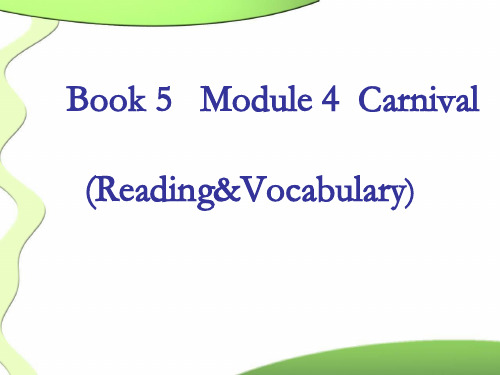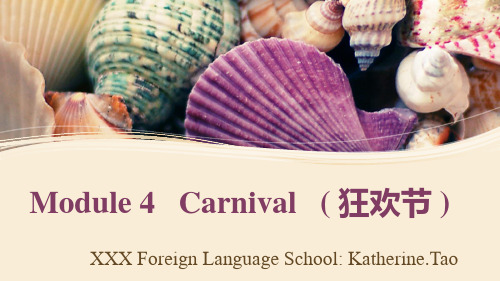Module4carnival狂欢节学习资料
- 格式:ppt
- 大小:4.17 MB
- 文档页数:27

精品文档Module 4 CarnivalI. 教学内容分析本模块的主题是狂欢节。
以西方的几种主要传统节日作为导入,接着通过各种活动详细介绍了狂欢节的历史、发展、种类及人们的活动、饮食、服饰和习俗。
其中有关食物和节日的词汇,和表达喜好和厌恶的句型又可以引申到中国传统节日和习俗,有益于培养学生的跨文化意识。
本模块从五幅西方节日图片的探讨开始,导入本模块的话题——Carnival。
Introduction 部分设计以西方的五种主要传统节日(Carnival, Holi, Halloween, Christmas, Thanksgiving Day)作为导入,让学生通过图片做配对练习了解西方的节日习俗,激发学生对西方节日的好奇心,达到导入整个模块的效果。
Reading and Vocabulary介绍有关狂欢节的一些知识,主要介绍了狂欢节的面具。
课文前后的四个相关练习帮助同学们学习和了解了相关词汇和文章主旨。
Grammar部分主要是通过练习复习被动语态在各种时态中的运用的语法项目。
Vocabulary and Listening分为词汇部分和听力两大部分。
词汇部分学习和巩固一些关于食物的单词;听力部分是关于西方节日的,对于同学们来说,听力材料偏生疏,因此听力要做一定的处理。
Learning to learn是关于通过听听力提高语音面貌的英语学习方法,对于提高学习策略水平有很大的帮助。
Everyday English通过学习复习Vocabulary and Listening中的句子学会一些非常有用的日常生活用语:give up, go wild about, more or less, high spot, funnily enough, in your blood, wash down 和walk off a meal。
Function介绍表达“喜欢、不喜欢和偏爱”的功能用语。
Reading and Writing集说话和写作于一体,培养的是学生语言综合运用的能力。


Module 4 Carnival巴西狂欢节被称为世界上最大的狂欢节,让我们阅读下面的文章一起走进巴西狂欢节吧。
The annual Carnival in Brazil is a unique festival.It is also the most important ethnic celebration.It comes between the end of February and the beginning of March every year.Hundreds of thousands of tourists from overseas were attracted to join the feast.The earliest Carnival dates back to 1641:people would be encouraged to parade,dance and drink to celebrate the birthday of the Portuguese King.More than three hundred years later,the Carnival has become the most important folk festival of Brazil.On February 24th of this year,the “King Momo” dressed in bright orange,took the gold key of the city from the mayor of Rio De Janeiro,to signify the beginning of Carnival.During the following five days,the “King”,who plays a leading role in the Carnival,would throw out all daily routines,so that people could indulge themselves.“King Momo”is also known as“the King of Carnival”.He is hand-picked by Rio residents.There was once a rule that required the “King”to weigh no less than 100kg.Today,there is a rule that the “King”shouldn't be heavier than 130kg.Seven hundred thousand tourists gathered in the coastal city of Rio De Janeiro for Carnival.Whoever they are-poor or rich,celebrity or ordinary people- they are all just dancers,day and night.Happiness prevails,while complaints disappear.[阅读障碍词]1.annual adj.每年的2.ethnic adj.种族的,民族的3.signify v.象征4.indulge vt.放纵5.prevail vt.盛行[诱思导读]1. Why did people celebrate carnival long long ago?To celebrate the birthday of the Portuguese King.2.Who selected the “King Momo”?Rio residents.Ⅰ.匹配下列单词的词性及汉语意思( )1.hide A.n.记忆( )2.confusion B.n.杂乱;混乱( )3.extend C.n.魅力;魔力( )4.pretend D.vt.掩藏;躲藏( )5.memory E.vt.延长( )6.wander F.vi.假装( )7.elegant G.vi.漫步;闲逛( )8.magic H.adj.优美的;高雅的[答案]1-4 DBEF 5-8 AGHCⅡ.选择下列句中相应词组的汉语意思and went to the party as she used to.2.The sun came out from behind the clouds late in the afternoon.3.You are sure to have fun at the party tonight.4.We have to wait until the discussion between them comes to an end.5.The traditional friendship between our two countries dates back to ancient days.6.The two young lovers decided to marry in secret,and they did so the very next day.[答案]1-3 CAF 4-6 BGEThe Magic of the MaskThink of carnival,and you think of crowds,costumes,and confusion①.The sounds and sights change from one country to another but the excitement is the same everywhere.面具的魔力想到狂欢节,你就会想到人群、服装和混乱。



外研版高二英语必修5Module 4 Carnival教案一、教学内容本节课选自外研版高二英语必修5 Module 4 Carnival,具体内容包括第1单元Reading and Vocabulary、第2单元Grammar和第3单元Reading and Writing。
详细内容如下:1. Reading and Vocabulary:介绍巴西里约热内卢狂欢节的历史、活动安排以及节日意义。
2. Grammar:讲解一般现在时、一般过去时和一般将来时的被动语态。
3. Reading and Writing:探讨狂欢节对当地经济和文化的影响。
二、教学目标1. 知识目标:学生能够掌握课文中的重点词汇、短语和语法结构,了解狂欢节的相关知识。
2. 技能目标:培养学生阅读、写作、听说等多方面的技能,提高学生的英语实际运用能力。
3. 情感目标:激发学生对世界各国文化的兴趣,培养学生的跨文化交际意识。
三、教学难点与重点1. 教学难点:一般现在时、一般过去时和一般将来时的被动语态。
2. 教学重点:课文中的重点词汇、短语以及狂欢节的相关知识。
四、教具与学具准备1. 教具:多媒体课件、黑板、粉笔。
2. 学具:教材、笔记本、字典。
五、教学过程1. 导入:通过展示巴西里约热内卢狂欢节的图片和视频,引发学生对狂欢节的兴趣,为新课的学习做好铺垫。
2. 阅读理解:学生自主阅读课文,完成相关练习,了解狂欢节的历史、活动安排和意义。
3. 语法讲解:教师讲解一般现在时、一般过去时和一般将来时的被动语态,并举例说明。
4. 例题讲解:分析教材中的例题,引导学生运用所学的语法知识进行改写句子。
5. 随堂练习:学生完成课堂练习,巩固所学知识。
6. 小组讨论:学生分组讨论狂欢节对当地经济和文化的影响,并进行汇报。
六、板书设计1. 课文Carnival2. 重点词汇:history、schedule、economy、culture3. 语法结构:被动语态(一般现在时、一般过去时、一般将来时)七、作业设计1. 作业题目:(1)用被动语态改写下列句子。
MODULE 4 Carnival学考目标导航重点单词识记理解: carnival n.狂欢节Christian adj. 基督教的ghost n.鬼;幽灵costume n.服装;戏装;化装服empire n.帝国council n. 地方议会;政务委员会elegant adj. 优美的;高雅的magic n. 魅力;魔力calendar n.日历;月历whistle n. 哨子tasty adj. 美味可口的multicultural adj.多元文化的;跨文化的plantation n.农庄;庄园parade n.(庆祝)游行landowner n. 地主;土地拥有者master n.主人magnificent adj .华丽的;富丽堂皇的freedom n.自由origin n. 起源import vt.引进;进口掌握运用: confusion n.杂乱;混乱extend vt.延长pretend vi.假装memory n.记忆book vt. 预订wander vi. 漫步;闲逛relaxing adj. 使人放松的mark vt. 标志(着)trade n.贸易transport vt. 运输;运送abolish vt. 废除celebration n. 庆典;庆祝revive vt. 复兴;再兴起;再流行unite vt. 联合重点短语识记理解: have fun过得愉快in secret秘密地put sb. into prison把某人关进监狱be crowded with充满(be) similar to.,与……相似(be) known as. .作为…而闻名wash down冲掉at the same time同时think much of对……评价高掌握运用: dress up装扮;打扮enjoy oneself玩得愉快come to an end结束on end连续地prepare for. .为……做准备date back to追溯到up to达到come off掉下refer to指的是consist of由……组(构)成be made of由……制成be forced to do被迫做more or less或多或少think of想到,想起take off脱下,摘掉walk off a meal用走路消化掉食物take over接手(管)重点句型:l. Think of carnival, and you think of crowds, costumes, and confusion.(“祈使句+ and+陈述句句型)2. People saw Carnival as a last chance to have fun at the end of the winter season. (see. . . as. . .把看成……..)3. Ordinary people could pretend to be rich and important, while famous people could have romantic adventures in secret.(while作并列连词)4. With the passing of time, the white inhabitants of the island began to take part in the carnival, too —and they were welcomed by their former slaves. (with the passing of time随着时间的推移) 情景交际Expressing likes, dislikes and preferences(表达喜好和厌恶)I love it. I quite like it. I really like it.It’s OK. I don’t think much of it. I hate it.—Do you like fish? —No, I don’t. I hate it. /Yes, l do. I quite like it.重点语法Review of the passive voice(复习被动语态)一般现在时:am/is/are+过去分词一般过去时:was/were +过去分词一般将来时:will/shal/ be+过去分词现在进行时:am/is/are being+过去分词过去进行时:was/were being+过去分词现在完成时:has/have been+过去分词过去完成时:had been+过去分词过去将来时:would be+过去分词写作指导就中国的节日写一封电子邮件考题源追踪:出自本模块的高考试题1. In April, 2009, President Hu inspected the warships in Qingdao, _______ the60th anniversary of the founding of the PLA Navy.A. markingB. markedC. having markedD. being marked2. He telephoned the travel agency to _______ three air tickets to London.A. orderB. arrangeC. takeD. book3.—1 just can’t stop worrying about the result of the job interview.—_______ .There’s nothing you can do now but wait..A. Relax B. Go ahead C. Go for it D. Good luck4.—Do you enjoy your present job?—_______. I just do it for a living.A. Of courseB. Not reallyC. Not likelyD. Not a little5. All visitors to this village _______ with kindness.A. treatB. are treated C .are treating D. had been treated6. Traditional folk arts of Tianjin like paper cutting _______ at the culture show of the 2010 Shanghai World Expo.A. are exhibitingB. is exhibitingC. are being exhibitedD. is being exhibited课文考点精解1. hide (hid, hidden) vt. 把……藏起来,躲藏;隐瞒Hearing someone come in, he hid himself behind the curtain.听见有人进来了,他一闪身藏在了窗帘的后面。